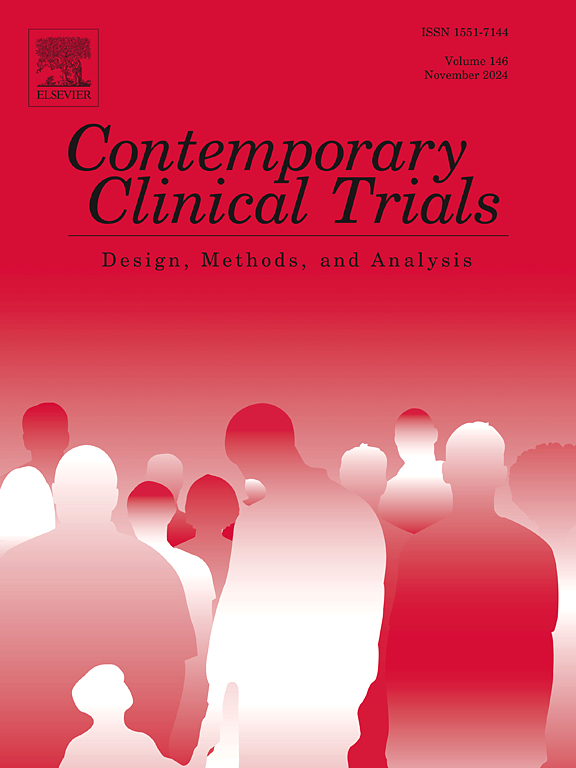Design of a pragmatic trial integrating human papillomavirus (HPV) self-sampling into primary care to reduce cervical cancer screening disparities in Somali American individuals: The Isbaar project
IF 2
3区 医学
Q3 MEDICINE, RESEARCH & EXPERIMENTAL
引用次数: 0
Abstract
Background
Somali American individuals have lower cervical cancer screening rates than the U.S. general population. Offering HPV self-sampling in primary care clinics could increase screening rates in Somali American individuals by addressing screening barriers.
Methods
The Isbaar Project is a Hybrid Type 2 effectiveness-implementation study of a patient-centered, culturally tailored HPV self-sampling intervention for Somali American individuals. Guided by the Consolidated Framework for Implementation Research and Social Cognitive Theory, we conducted focus groups with Somali American individuals, and interviews with clinicians and clinic staff to inform refinement and development of implementation strategies. HPV self-sampling was then implemented as a usual care screening option at 3 community-based primary care clinics in Minneapolis, Minnesota in February 2023. The primary objective is to assess the effect of implementing in-clinic HPV self-sampling on screening completion in Somali American individuals. The secondary objective is to assess the effect of implementing HPV self-sampling on screening completion in all patients. Using difference-in-difference methods, we will evaluate changes in screening rates one-year pre and post implementation and compare changes with control clinics followed over the same time period. Using RE-AIM, we will conduct a post-implementation mixed methods analysis of processes and strategies needed to successfully implement HPV self-sampling in primary care.
Conclusions
The study was designed to evaluate a real-world in-clinic HPV self-sampling intervention for Somali American individuals, generating data on both effectiveness and implementation applicable to other community-based clinics in the U.S. The objective of this report is to describe the rationale and design of the study.
设计一项将人类乳头瘤病毒(HPV)自我采样纳入初级保健的实用试验,以减少美国索马里人的宫颈癌筛查差异:Isbaar 项目。
背景:索马里裔美国人的宫颈癌筛查率低于美国普通人群。在初级保健诊所提供 HPV 自我采样可通过解决筛查障碍来提高索马里裔美国人的筛查率:Isbaar 项目是一项混合型 2 效能实施研究,研究对象是以患者为中心、针对索马里裔美国人文化背景量身定制的 HPV 自我采样干预措施。在 "实施研究综合框架 "和 "社会认知理论 "的指导下,我们对索马里裔美国人进行了焦点小组讨论,并对临床医生和诊所工作人员进行了访谈,以便为实施策略的完善和发展提供信息。随后,我们于 2023 年 2 月在明尼苏达州明尼阿波利斯市的 3 家社区初级保健诊所实施了 HPV 自我采样,作为常规护理筛查选项。主要目标是评估在诊所内实施 HPV 自我采样对美国索马里人完成筛查的影响。次要目标是评估在所有患者中实施 HPV 自我采样对筛查完成率的影响。我们将采用差分法评估实施前后一年筛查率的变化,并与同期跟踪的对照诊所进行比较。利用 RE-AIM,我们将对在初级保健中成功实施 HPV 自我采样所需的流程和策略进行实施后混合方法分析:本研究旨在评估针对索马里裔美国人的诊所内 HPV 自我采样干预措施的实际效果,从而生成适用于美国其他社区诊所的有效性和实施情况的数据。
本文章由计算机程序翻译,如有差异,请以英文原文为准。
求助全文
约1分钟内获得全文
求助全文
来源期刊
CiteScore
3.70
自引率
4.50%
发文量
281
审稿时长
44 days
期刊介绍:
Contemporary Clinical Trials is an international peer reviewed journal that publishes manuscripts pertaining to all aspects of clinical trials, including, but not limited to, design, conduct, analysis, regulation and ethics. Manuscripts submitted should appeal to a readership drawn from disciplines including medicine, biostatistics, epidemiology, computer science, management science, behavioural science, pharmaceutical science, and bioethics. Full-length papers and short communications not exceeding 1,500 words, as well as systemic reviews of clinical trials and methodologies will be published. Perspectives/commentaries on current issues and the impact of clinical trials on the practice of medicine and health policy are also welcome.

 求助内容:
求助内容: 应助结果提醒方式:
应助结果提醒方式:


